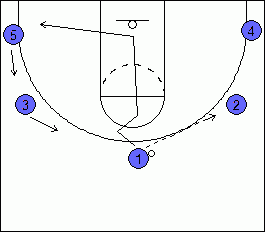Basketball Wheel Offense Pdf
Garland Pinholster Wheel Offense Playbook by Wes Kosel Here is a Garland Pinholster Wheel Offense playbook based on notes and diagrams from Coach Garland Pinholster. Coach Pinholster is credited for the innovation of the wheel offense.
Fourth Grade Girls Basketball Wheel Offense
Animated basketball play called wheel offense. From the category: offense wheel. Wheel Offense - vs 2-3zone pg.3 Printed from FromtheFastModel SportsPlays and.
He created the Garland Pinholster Wheel Offense in the late 1950s while coaching at Oglethorpe University (Georgia). He coached 10 years at Oglethorpe compiling a 180-68 record at Oglethorpe and was 276-89 during his career as a college coach.

In the notes, Coach Pinholster states that he didn’t create this offense, but that his opponents created it for him. The Garland Pinholster Wheel Offense came out of a need for a single formation to attack both man to man and zone defenses. Opponents would alternate defenses against his teams, and Pinholster didn’t like the way his teams had to reset into either a man or zone offense. The Garland Pinholster Wheel Offense got the name “Wheel” because it has a hub (the pivot man), spokes (the 4 other players), and the spokes rotate around the middle and revolve like a wheel. Also, the wheel can be run at different speeds and can be stopped and reversed. This is a continuity offense that moves the players in a circular, or wheel-like pattern to create scoring opportunities.
Pinholster had great defensive teams, and used this offense to keep possession so that the opposing team had fewer possessions and therefore fewer opportunities to score. The first chapter is an overload 1-3-1 formation, with 3 players in a line down the side of the key and one player on each wing. This chapter has several cutting options and strategies for running the wheel out of this formation. The second chapter is counter movement options out of the 1-3-1 formation.
Chapter 3 is a 2-1-2 formation with 4 players out and 1 player inside at the high post. The 2-1-2 is used as a concealment strategy, and 3 options are shown for transitioning from the 2-1-2 concealment into the 1-3-1 formation. I hope you enjoy this playbook. Coach Wes Kosel Wes Kosel is an assistant coach for men’s basketball under Head Coach Tommy Jones at Texas Lutheran University in Seguin, TX.
2013-2014 marks the second year for Kosel at TLU. Prior to arriving at TLU, Kosel served as a student assistant coach under Head Coach Chad Killscrow at Haskell Indian Nations University in Lawrence, KS. Kosel has an undergraduate degree in Exercise Science from the University of Kansas, and is pursuing a Master’s degree in Physical Education from the University of Houston. The Bartlesville, OK native is also a NSCA Certified Strength & Conditioning Specialist (CSCS), and teaches weight training and aerobic fitness courses at Texas Lutheran.
He has coached AAU programs, volunteered with elementary and middle school basketball teams, and has worked basketball camps for various programs including the Houston Rockets, University of Houston, Texas State, and Texas A&M Corpus Christi.
Without a shot clock here in Ohio, some teams like to work the clock for the best scoring opportunity. This is a great continuity offense based on the Flex Offense, which provides coaches quick scoring opportunities or the ability to work the ball around and designate which shots you want and from where.
Starting this offense out of a 3-out/2-in setup allows the opportunity for coaches to run their transition, secondary, or other set plays directly into this continuity. Against teams that really pressure the ball and deny passes, moving the wings around by having 4/5 set downscreens, crossing guards underneath, or whatever coach’s desire allows for multiple entry options. Your best post-up player should be the 5 man, as this position keeps him receiving the baseline flex screen to getting scoring chances at the basket. He/she should be smart enough not to just run back and forth on the baseline, but rather know how to setup cuts and seal his/her defender.
All of the other positions are interchangeable, so the players should be comfortable starting at any position. The constant motion makes it difficult for defenders to constantly be in helpside, and often leads to chasing cuts.
Our teams have been most successful with this offense after reversing it a few times. We never wanted to pass to the first wheel cutter going through the lane because: a) we wanted to be able to get the 5 man coming across, and b) changing sides of the floor open all of the cuts after the second time through. Whether you’re experienced with the traditional Flex offense or new to the system, this offense is a great fit for many different types of teams. Those who are stronger and like to slow it down and bruise the other team will like the screening and post seals, just like those quicker teams that rely on speed will like the basket cuts and driving opportunities.